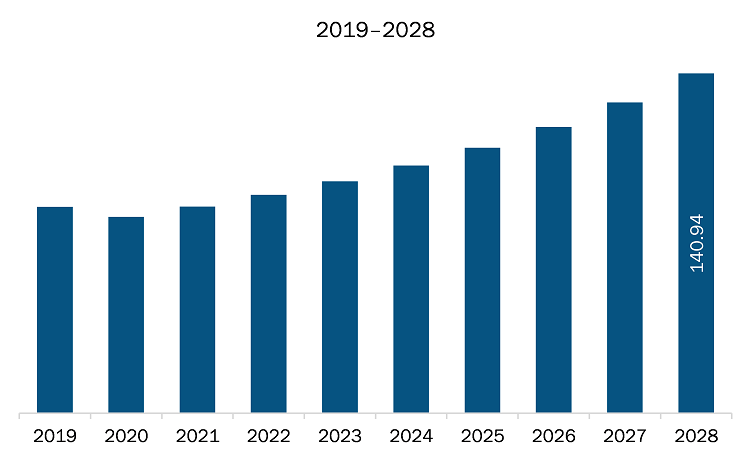The arbitrary waveform generator market in North America is expected to grow from US$ 85.67 million in 2021 to US$ 140.94 million by 2028; it is estimated to grow at a CAGR of 7.4% from 2021 to 2028.
The US, Canada, and Mexico are major economies in North America. Extensive application in equipment testing across industries is the major factor driving the growth of the North America arbitrary waveform generator market. The arbitrary waveform generators are widely used as test equipment across various industries. Since the wave shapes produced by the generators can be programmed independently by the user, they perform a wide variety of signal applications such as channel summing, synchronization, and noise generation. The demand for arbitrary waveform generators is rising with the increasing need for testing, measuring, and monitoring devices requiring high electronic precision. Since the volume and density of semiconductor components are on the rise in electronic devices, these generators are commonly used to test the functioning of every aspect of these components. In the aerospace & defense industry, the arbitrary waveform generator is ideal for sensor simulation in military and avionics communication, as well as system test applications having a large number of DC/AC signal sources. Therefore, higher adoption of electronic devices, increased demand from aerospace & defense industry, and ongoing advancements in communication technologies are bolstering the growth of the arbitrary waveform generator market, which is further anticipated to drive the market in North America.
The containment measures taken during the COVID-19 pandemic have led to decrease in the production of commodities, goods, and services. The manufacturing sector has witnessed a decline in operations due to temporary shutdown of activities. The electronics industry took a significant hit due to the lowered demand for electronic components from the industrial sector and other end users. A decline in the revenue of the electronics industry, especially in the first half of 2020, is attributed to the lack of inability to carry out mass production due to social restrictions. Post lockdown, the semiconductors & electronics sector started regaining the market share as production facilities resumed operations by taking social distancing measures
North America is a prominent adopter of smart or IoT-based devices due to favorable infrastructure that supports high-speed internet services. The adoption of 5G network is further likely to fuel the arbitrary waveform generators market growth post lockdown.
- This FREE sample will include data analysis, ranging from market trends to estimates and forecasts.
North America Arbitrary Waveform Generator Market Segmentation
North America Arbitrary Waveform Generator Market – By Channel
- Single-channel
- Dual-channel
- Multi-channel
North America Arbitrary Waveform Generator Market – By Technology
- Direct Digital Synthesis AWG
- Variable-clock AWG
- Combined AWG
North America Arbitrary Waveform Generator Market – By Bandwidth
- Below 1GHz
- 1 – 5 GHz
- 5 – 10 GHz
- 10 – 25 GHz
- 25 – 32 GHz
- 32- 50 GHz
- Above 50 GHz
North America Arbitrary Waveform Generator Market – ByApplication
- Telecommunication
- Education
- Healthcare
- Electronics
- Others
North America Arbitrary Waveform Generator Market, by Country
- US
- Canada
- Mexico
North America Arbitrary Waveform Generator Market-Companies Mentioned
- B&K Precision Corporation
- BERKELEY NUCLEONICS CORPORATION
- KEYSIGHT TECHNOLOGIES
- Pico Technology
- Rohde & Schwarz
- SHF Communication Technologies AG
- Tabor Electronics Ltd.
- TEKTRONIX, INC
- Teledyne LeCroy
- Texas Instruments Incorporated
North America Arbitrary Waveform Generator Report Scope
| Report Attribute | Details |
|---|---|
| Market size in 2021 | US$ 85.67 Million |
| Market Size by 2028 | US$ 140.94 Million |
| CAGR (2021 - 2028) | 7.4% |
| Historical Data | 2019-2020 |
| Forecast period | 2022-2028 |
| Segments Covered |
By Channel
|
| Regions and Countries Covered |
North America
|
| Market leaders and key company profiles |
|
- Historical Analysis (2 Years), Base Year, Forecast (7 Years) with CAGR
- PEST and SWOT Analysis
- Market Size Value / Volume - Regional, Country
- Industry and Competitive Landscape
- Excel Dataset
Recent Reports
Testimonials
Reason to Buy
- Informed Decision-Making
- Understanding Market Dynamics
- Competitive Analysis
- Identifying Emerging Markets
- Customer Insights
- Market Forecasts
- Risk Mitigation
- Boosting Operational Efficiency
- Strategic Planning
- Investment Justification
- Tracking Industry Innovations
- Aligning with Regulatory Trends





















 Get Free Sample For
Get Free Sample For